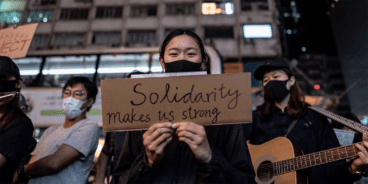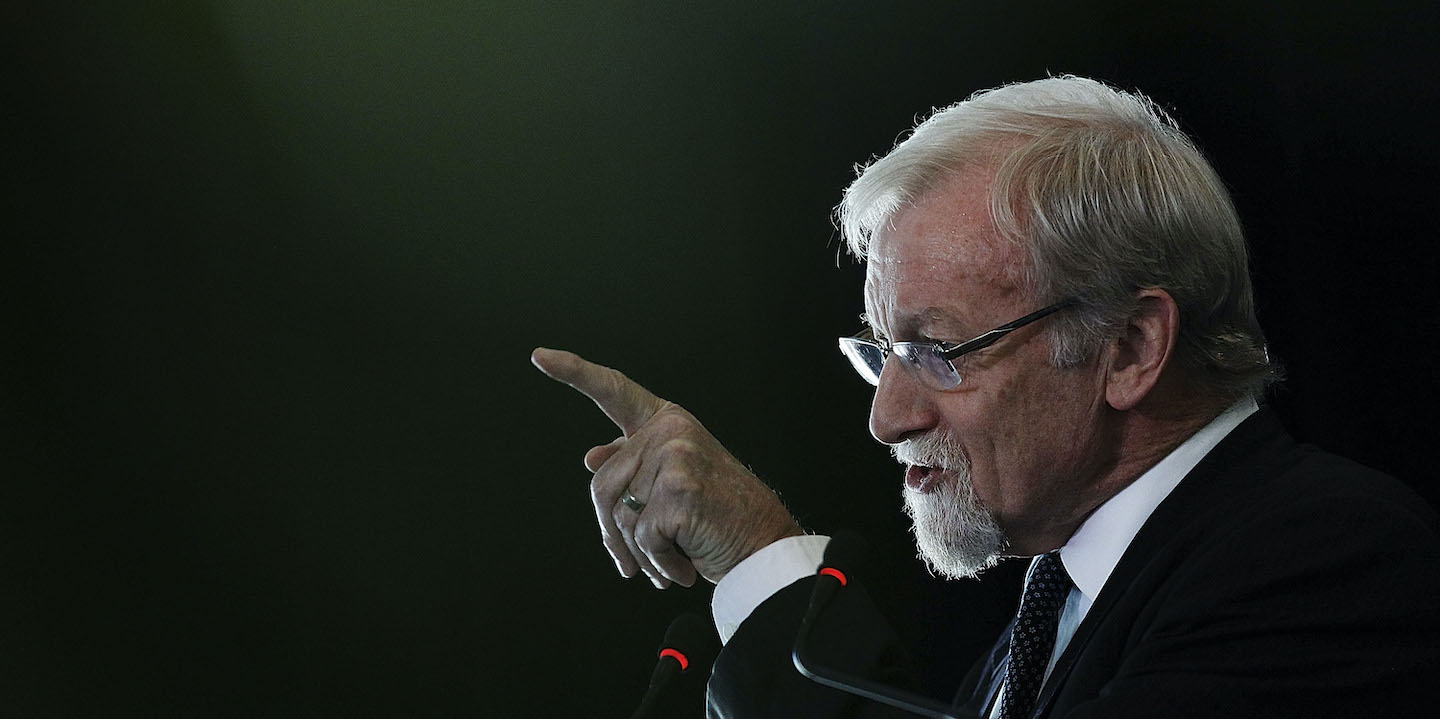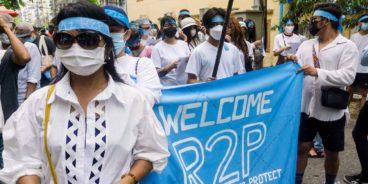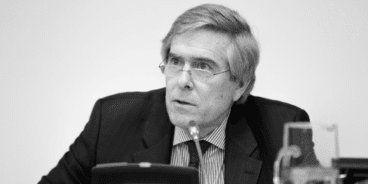

*This speech was originally delivered at the European Centre for the Responsibility to Protect’s Annual Lecture, (Virtually delivered) at Leeds University, 26 November 2020. An audio recording of the lecture is available on their website here.
___________________________________________________________________________
In a world as full of cynicism, double standards, crude assertions of national interest and realpolitik as ours has so long been, not least in these last few years, it is very easy to believe that ideas do not matter very much. Achieving fundamental change in the way states and their leaders think and behave is as hard as international relations gets. But that is exactly the dream that those of us involved in the creation of the Responsibility to Protect (R2P) concept set out to make a reality two decades ago.
Most of you will be familiar with the background, but let me quickly recapitulate its key elements. Slaughtering people not for anything they do, but simply for who they are – their national, ethnic, racial, religious, or political identity – is morally as bad as it gets. Yet in the twentieth century that was the fate of at least 80 million men, women and children, including Armenians in Turkey, Jews in Europe, suspect classes in the Soviet Union and China, communists in Indonesia, non-communists in Cambodia, Bengalis in former East Pakistan, Asians in Uganda, Tutsis in Rwanda, and Muslims in the former Yugoslavia.
With a new explosion of genocidal violence in the Balkans and Central Africa in the 1990s, it became apparent that, even after the horrors of the Holocaust and all the many developments in international human rights and humanitarian law that followed World War II, the international community was still a completely consensus free zone when it came to the ‘right to intervene’ to halt or avert mass atrocity crimes – genocide, ethnic cleansing, other crimes against humanity and large scale war crimes. As United Nations Secretary-General Kofi Annan lamented to the General Assembly in 2000, ‘If humanitarian intervention is indeed an unacceptable assault on sovereignty, how should we respond to a Rwanda, to a Srebrenica – to gross and systematic violations of human rights that offend every precept of our common humanity?’
The Dream. That challenge was answered, and the beginnings of a new consensus forged, in the report in 2001 of the Canada-sponsored International Commission on Intervention and State Sovereignty, which I had the pleasure and privilege of co-chairing with the brilliant African diplomat, the late Mohamed Sahnoun. Our Commission initiated the breakthrough concept of the ‘responsibility to protect’ (known for better or worse ever since by the abbreviation ‘R2P’), which made it politically possible for the first time for the global North and South to find common ground, I think for four reasons.
First, there was the language we used – the ‘responsibility to protect’ being much less inherently abrasive than the ‘right to intervene’. Second, there was our emphasis on multiple actors sharing that responsibility, not just the big military players. Third, there was our emphasis on multiple layers of response – on preventive strategies, not just reactive ones, and on a whole continuum of reaction measures, not just military ones but including diplomatic isolation, and sanctions and embargoes, and threats of International Criminal Court prosecution. And fourth, there was our insistence that the bar for any military intervention be set very high, with legality dependent on Security Council endorsement, and legitimacy dependent on satisfying clear prudential criteria, including proportionality and doing, on balance, more good than harm.
Eventually, after a long and fraught diplomatic process, the UN General Assembly, sitting at head of state and government level at the 2005 World Summit, unanimously endorsed the principle of R2P, with its three distinctive pillars (although these pillars were not articulated quite so clearly as such until the Secretary-General’s report to the Assembly four years later, in 2009): the responsibility of a state to its own people not to either commit such mass atrocity crimes or allow them to occur (‘Pillar One’); the responsibility of other states to assist those lacking the capacity to so protect (‘Pillar Two’); and the responsibility of the international community to respond with ‘timely and decisive action’ – including ultimately with coercive military force if that is authorised by the Security Council – if a state is ‘manifestly failing’ to meet its protection responsibilities (‘Pillar Three’).
The 2005 World Summit brought us closer than we had ever been before to realising the dream of making ‘Never Again’ more than a slogan. To have heads of state and government across the globe accept unanimously that such crimes were a matter of international peace and security concern even when committed wholly within the boundaries of a single sovereign state was on any view a diplomatic triumph.
The Reality. But that was all then, and now is now. Fifteen years later, in this pandemic-reoccupied, sovereignty-re-obsessed, post-truth, post-rationality, post-decency, and not yet post-Trumpian world we now seem to largely inhabit, there is nothing like the same optimism that the international community has either the capacity or will to halt or avert another Cambodia, Rwanda or Srebrenica, those talismanic horror-cases that so influenced both the crafting of the R2P concept by the Commission I co-chaired, and the unanimous embrace of all its key elements by the United Nations. There are plenty of cynical voices to be heard saying that the whole enterprise has been a complete waste of time, or worse. And looking at the genocidal catastrophes that have continued to occur in places like Sri Lanka, Myanmar, Yemen and above all Syria, that’s not an easy argument to contest.
But contest it I do, taking as my benchmarks the four big things that R2P was designed to be: a normative force; a catalyst for institutional change; a framework for preventive action; and a framework for effective reactive action when prevention has failed. There is zero room for complacency. But if we take hard, objective stock of what has, and has not, been accomplished over those fifteen years, there is much to celebrate, and much still to be reasonably optimistic about on each of these four fronts.
Normatively, the concept of ‘the responsibility to protect’ has achieved a global acceptance unimaginable for the earlier concept of ‘the right of humanitarian intervention,’ which R2P has now rightly and almost completely displaced. Although many states are still clearly more comfortable with the first two pillars of R2P than they are with the third, and there will always be argument about what precise form action should take in a particular case, there is no longer any serious dissent evident in relation to any of the elements of the 2005 Resolution. The best evidence for this lies in the General Assembly’s annual debates since 2009, which have shown consistent, clearly articulated and overwhelming numerical support for what is now widely accepted as a new political (if not legal) norm, and in the more than eighty resolutions and presidential statements referencing R2P that have now been generated by the Security Council (the great majority of them coming after the bitter disagreements over Libya in 2011, which I will come back to).
I don’t suggest for a moment – particularly with Russia, and increasingly China, playing the spoiling role they now have on the Security Council – that R2P has become so embedded in international practice that it now counts as a new rule of customary international law. But when considered as a guide to behaviour, I believe that R2P is more than just an ‘emerging’ norm: it is a new norm.
Institutionally, R2P has brought more organized attention to civilian response capability, and to the need for militaries to rethink their force configuration, doctrine, rules of engagement, and training to deal better with mass atrocity response operations. Importantly, more than sixty states and intergovernmental organizations – most recently the Organization of American States – have now established R2P ‘focal points’ – designated high-level officials whose job is to analyse atrocity risk and mobilize appropriate responses. They have been encouraged to do so by indefatigable lobbying and secretarial support from the Global Centre for the Responsibility to Protect, the New York based NGO whose International Advisory Board – full disclosure! – I continue to chair, and whose website, I have to say, is an excellent resource for anyone interested in any aspect of R2P.
Creating a culture of more effective support for the institution of the International Criminal Court (ICC) is crucial not only for the trial and punishment of some of the worst mass atrocity crimes of the past, but to deter future perpetrators. Implementation of the ICC’s mandate may not always have been perfect in its early years, but the court does not begin to deserve the attacks upon its integrity it has endured from some African leaders and, above all, the Trump administration. There are encouraging recent signs that the wheel may be turning for international criminal justice, with the long-overdue arrest of Sudan’s former President al-Bashir, the apprehension of the notorious Rwandan genocidaire Felicien Kabuga, and the Gambia-initiated case filed against Myanmar at the ICJ for their atrocities against the Rohingya. And there is every reason to believe that the new Biden administration – while joining the Rome Treaty itself will no doubt be a bridge too far for the Congress – will reverse the US sanctions on the Court and, as with President Obama’s, be far more supportive of its role.
Preventively, R2P-driven strategies have had a number of successes, notably in stopping the recurrence of violence in Kenya, the West African cases of Sierra Leone, Liberia, Guinea, Côte d’Ivoire and The Gambia, and in Kyrgyzstan. Today, some volatile situations such as the ongoing crisis in Central African Republic, get recurring Security Council attention of a kind unknown to Rwanda in the 1990s. Strong civilian protection mandates are now the norm in peacekeeping operations. And the whole preventive toolbox—long-term and short-term, structural and operational—is much better understood.
But, although prevention is very much the UN flavor of the month – and has been the main focus of successive Secretary-General’s reports and General Assembly debates – action still lags behind the rhetoric. Part of the problem of getting sufficient resources to engage in successful prevention is the age-old one that success here means that nothing visible actually happens: no-one gets the kind of credit that is always on offer for effective fire-fighting after the event.
Coming to the last of my my four benchmarks, how effective has R2P been reactively? This is arguably where it matters most that R2P make a difference – stopping mass atrocity crimes that are under way, whether through diplomatic persuasion, stronger measures like sanctions or criminal prosecutions, or through military intervention. But the not-so-good news is that R2P’s record here has been on any view disappointing, at least in recent years. On the positive side are success stories again in Kenya and Côte d’Ivoire, and (at least initially, in stopping the almost universally-feared massacre in Benghazi) Libya, as well as the partial successes that can be claimed for UN operations in the Congo, South Sudan, and the Central African Republic. But against these must be weighed serious failures in Sri Lanka, Sudan, Myanmar, Yemen and, above all, Syria.
The crucial lapse in Syria occurred in mid-2011, when the Assad regime’s violence was one-sided and containable. Driven by the perception, not itself unreasonable, that the Western powers – the US, UK and France – had overreached in Libya by stretching a limited mandate to protect civilians into a regime-change crusade, a number of Security Council members then over-reached in the other direction. Seeing as they did another slippery slope ahead of them in Syria, there was no majority support for a resolution even just to condemn the regime’s violence against unarmed civilians. And with the Syrian leadership sensing its impunity, the situation deteriorated quickly into the full-scale civil war still dragging on disastrously today.
Re-establishing Security Council consensus in these hardest of cases will be extremely difficult, not least at a time of increasing hostility between the United States and China, and continuing recalcitrance by Russia. But, particularly with an early American return under President Biden to something approximating responsible global citizenship, it is not impossible.
That said, when it comes to R2P, we cannot place all our eggs in the US basket, particularly when it comes to the really sharp end of the debate: supporting military action in extreme cases. Although support is still evident in national public opinion polls, and is on the record from leading Democrat figures (including Joe Biden’s putative Secretary of State Tony Blinken), for effective action against genocide and other mass atrocity crimes, the overall national US mood has turned even more obviously against foreign military engagements. The Obama administration, admirably principled as it was in so many ways, was even reluctant to publicly use ‘R2P’ terminology outside UN corridors, preferring – as even the most responsible US administrations tend to, and I suspect the Biden presidency will be no different – not to be committed to any general principles at all which might undercut its capacity to treat cases, like or unlike, as differently as it chooses to: what I call the American devotion to the ‘divine right of ad hocery’.
The Future. Whatever the uncertainties that lie ahead in the medium term, I am optimistic enough to believe that R2P has a future, in all its dimensions. As one of those who conceived it, I can attest that R2P was designed for pragmatists rather than purists, with full knowledge of the messy reality of real-world state motivations and behaviour. It was designed not to create new legal rules but rather a compelling new sense of moral and political obligation to apply existing ones. And for all that continues to go wrong, real progress has been made in achieving just that: a new norm of international behaviour which, overwhelmingly, states feel ashamed to violate, compelled to observe, or at least embarrassed to ignore.
While there will always be argument about what preventive or reactive tools are appropriate in particular cases – and while occasional thuggish defiance of any global consensus is, unhappily, probably inevitable – it is much harder than it used be to identify any state anywhere whose leadership sees no place for any toolbox at all.
I see little visible stomach anywhere for a return to the bad old days when genocide and other appalling crimes against humanity committed behind sovereign state walls were of no concern to anyone but their victims. While “Never Again” has too often in the past been a hollow cry, with the advent of R2P I think we can say it has at least recovered its power to shame.
All that said, R2P in many ways remains work in progress, and there is much more work to be done in consolidating its effectiveness. The future of the responsibility to protect will only be assured if we – and in particular the next generation of policymakers — fight for it. Like almost everything else that matters when it comes to attitudinal and behavioural change, domestically or internationally, the momentum for change can come from three different directions – top-down, sideways from peer group members, and bottom-up. And it is obviously most successful when initiatives and pressure are coming from all three.
As to top-down moves, there is no more important or urgent task for R2P advocates than to rebuild consensus within the Security Council as to the right way to handle the hardest of cases. It is important in this respect, even if not immediately likely to resonate with the states that matter most, that new momentum be generated in support of two initiatives in particular. First, the French proposal of a few years ago that the five permanent members of the Security Council enter a voluntary self-restraint agreement not to exercise their veto in mass atrocity cases, and the related proposal by the so-named Accountability, Coherence and Transparency (ACT) Group for a Code of Conduct binding all Council members when dealing with atrocity situations. Together, these parallel initiatives have been signed by over 120 governments.
The other top-down initiative which I would love to see re-energised is the Brazilian ‘Responsibility While Protecting’ (RWP) proposal, crafted in 2011 as a solution to the impasse over Libya, which would require all Council members to debate more comprehensively the criteria that need to be met before any use of force is authorized, and to accept close monitoring and review of any coercive military mandate throughout its lifetime. Russia and China have shown some willingness to go down this path in the past, and — their preference for ad hocery apart, unhappily not confined to Washington — there is no good reason in for the US, UK or France to oppose it.
Sideways, or peer group pressure and activism can be very important in generating new international standards of behaviour, and adherence to existing ones, including by the biggest global players. The UN Group of Friends, with over fifty members and chapters in both New York and Geneva and for which again the Global Centre on R2P acts as the secretariat, is an important mobilising force in the UN system. Regional organizations have a particular role to play here, as the Arab League did over Libya, and the African Union and ECOWAS in West Africa have repeatedly demonstrated.
Middle powers can be important coalition builders and norm setters, as Canada demonstrated in in initiating not only the Commission which gave birth to R2P, but the Ottawa treaty banning land mines. My own country, Australia, has in the past also played a major energising role on global public goods issues – and has been a leading supporter of R2P from the beginning – but we have unhappily tarnished our human rights reputation in recent years, in particular with our treatment of asylum seekers, and the recent shocking revelation of war crimes committed by our special forces in Afghanistan. Credible advocates have to have their own house in order.
As to bottom up pressure, it is critical to acknowledge the importance of ordinary individuals in the community making their voices heard on these issues, whether through an NGO or a political party or just as concerned citizens. Effective atrocity prevention depends above all else on the exercise of political will of those in power, and getting decision makers off their backside depends – as I know better than most after 21 years in politics and government – on them hearing, loudly and clearly, many passionate community voices telling them that human lives are at risk and that inaction is intolerable.
Staying Optimistic. My last words are on the critical necessity for all of us, governments, intergovernmental organizations, NGOs and ordinary citizens is to stay optimistic, to go on believing that what we do can and will make a difference. The crucial point is that in international relations, as in life itself, outlooks can be self-reinforcing. Pessimists see conflict, horror and sheer human idiocy of one kind or another as more or less inevitable, and adopt a highly wary and competitive approach to the conduct of international relations. But for optimists of all stripes and colours, what matters rather is believing in and nurturing the instinct of cooperation in the hope, and expectation, that decent human values will ultimately prevail. If we want to change the world for the better, we must start by believing that change is possible.
But while optimism may be self-reinforcing, it is not self-fulfilling. When things that matter get depressing and difficult, however disappointed and frustrated we may be, there is no alternative but to try actively to remedy them, in every way one realistically can. You don’t get to change the world simply by observing it. You have to get out there and work for change. It’s too late now for me and my generation to make much difference, but I say to this largely student audience: yours very much can, and I very much hope you will.
Related Content


Applying R2P to Myanmar
